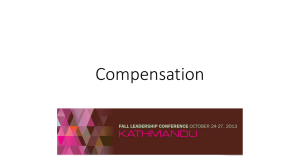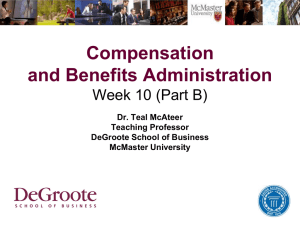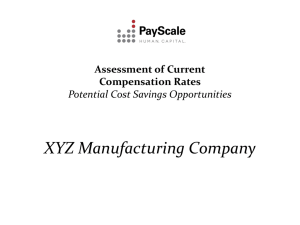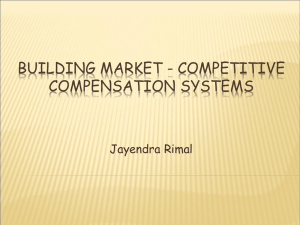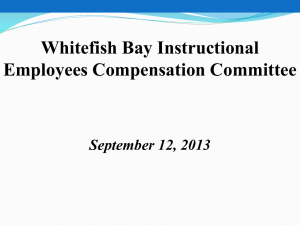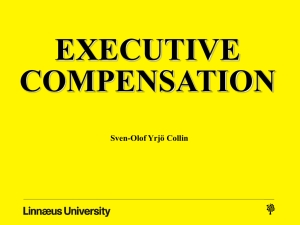here - School District of Greenfield
advertisement
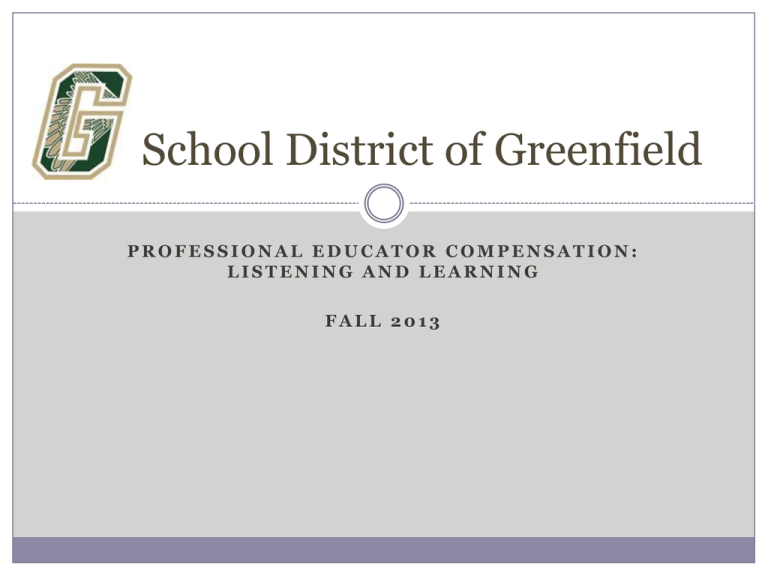
School District of Greenfield PROFESSIONAL EDUCATOR COMPENSATION: LISTENING AND LEARNING FALL 2013 What is compensation? Salary (wages) is an element of the compensation system. Other elements include: Health insurance Life insurance Dental insurance Wisconsin Retirement System Post-employment benefits For most teachers, salary will account for 50-75% of the total compensation package. Example: for a teacher with a salary of $50,000, the salary accounts for 70% of the total compensation How was salary determined? Salary for teachers was determined by a system of lanes and steps Teachers advanced on the scale based on years of service and educational lane advancement How was salary determined? Since 1970s, salaries for teachers were formally bargained per state law Under former state law, increases to teacher compensation needed to reach the Qualified Economic Offer (QEO) which was set at 3.8% The QEO did not include advancement on the lanes/step system So, aggregate teacher compensation often rose higher than 3.8% annually when lane/steps were considered, as well as benefit cost increases Benefits and challenges of the lane/step model Benefits: Predictable; Rewarded longevity; Provided clear pathways to higher earnings. Challenges: Unsustainable increases relative to per pupil allowances and increased costs in other areas (e.g., health insurance, utilities) Compensation-related costs were increasing at a rate of 5-10% annually while revenue authority growth was only 2% Compensation was “back-loaded” towards those in the last few years of employment and beyond Often there was a 100% variance between the lowest and highest paid teacher (e.g., teacher at $70,ooo and $35,000) Where are we now? Since 2011, most Wisconsin school districts have frozen salary scales and provided across-the-board (ATB) increases in a certain amount or percentage Advancement on the lane/step system has largely ceased Stipends have been offered to those who were enrolled in a graduate program What are we going to do about salaries? What’s going on elsewhere… Lane & step model is being phased out Big salary jumps are unlikely to occur (i.e., BA to MA to MA +30) based on educational attainment Most districts are going to a tiered approach Moving from one tier to a higher tier is largely based on experience/evaluation cycle Each tier has a higher base salary Some districts are looking at merit pay, or Pay-for-Performance systems What is the purpose of compensation? A good compensation plan will: Attract teachers to Greenfield Retain teachers in Greenfield Be fair, transparent and easily understood Make compensation a non-topic Reward desired behaviors aligned with the District’s culture & mission What is the purpose of compensation? What does “reward desired behaviors aligned with the District’s culture & mission” mean? Easily put, it is professional development: of value to the district, to meet specific needs of the district, that helps individuals improve their performance to increase student achievement, and, will not be the same for all teachers. What is the purpose of compensation? Compensation is a part of the attraction and retention of staff To the extent that compensation results in the attraction/retention of staff, what should be done? What else can be offered to employees? Some differentiation in compensation may be necessary to attract teachers to hard-to-fill certifications; Some differentiation may be needed to attract other skill sets such as bilingual or multiple certification teachers; Minimize damage to teacher morale resulting from salary differentiation. What is the purpose of compensation? Are teachers (are you) motivated by increased compensation? Is higher compensation an adequate reward? What else attracts/retains/motivates people? What behaviors do we need/want to reward? Does rewarding advanced educational degrees serve the District’s interests? Should student performance affect teacher compensation? Your thoughts and ideas




